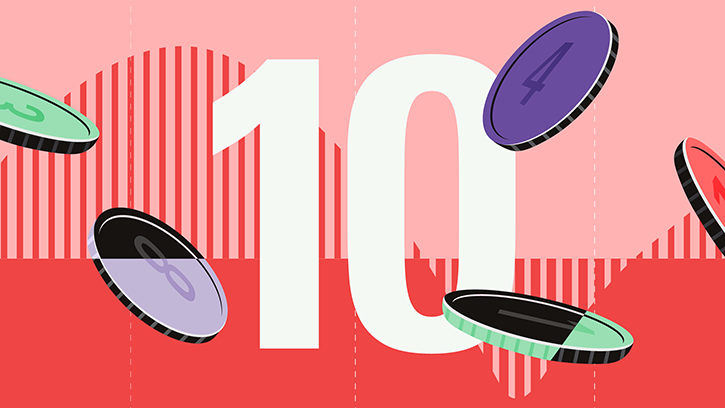
US equity-focused exchange traded funds (ETFs) are, unsurprisingly, leading the way as the best performers in 2018 so far, with emerging market funds lagging, according to Morningstar Direct data.
Despite the FAANG stocks gaining plenty of traction in the year to date, though, it was a pair of small-cap ETFs that topped the performance chart. Of the 53 Morningstar top-rated ETFs listed in London, the 15 best performers were US equity related.
At the bottom of the table, after numerous country-specific mini-crises in the likes of Turkey, Argentina and Venezuela, emerging market offerings struggled, with three top-rated ETFs sitting on double-digit losses. Japanese equity trackers also performed poorly in the first eight months of the year.
US Small Caps Outperform
The two best performers in 2018 so far were the iShares S&P Smallcap 600 ETF (IDP6) and the SPDR Russell 2000 US Small Cap ETF (R2US), which returned 16.39% and 12.19% in US dollar terms respectively.
The pair have different characteristics, with the iShares offering having more of a focus on profitable companies. Its underlying benchmark, the S&P 600 Smallcap Index, screens out loss-making stocks and recent IPOs. The firm is the only provider to track the index.
The SPDR mandate, meanwhile, does not fully replicate its Russell 2000 Index as that process tends to be expensive and inefficient. Instead, it holds around 80% of the index’s constituents. “This approach has largely contributed to the fund’s outperformance relative to its benchmark,” says analyst Monika Dutt.
ETFs in the US Small Cap category saw their highest monthly net inflows in both June and July since the election of Donald Trump in late 2016, with over €550 million invested over those two months.
Lyxor Leads Gold-Rated S&P Trackers
The next six in line are S&P 500 trackers, and all have returned somewhere in the region of 8% to 9% in US dollar terms. They are led by Lyxor S&P 500 ETF (LSPU), iShares S&P 500 ETF (IDUS) and SPDR S&P 500 ETF (SPY5).
These Gold-rated offerings are, of course, dominated by the two first ever $1 trillion companies, Apple (AAPL) and Amazon (AMZN), as well as the likes of Microsoft (MSFT), Alphabet (GOOGL) and Facebook (FB).
The trio all fully replicate the S&P 500 index, which is often cited as one of the toughest benchmarks for active managers to beat, giving these ETFs an advantage.
Dutt notes that the iShares fund had underperformed peers before the firm cut fees to 0.07% from 0.4% in 2017. Now, it’s outperforming peers.
Emerging Markets Struggle
Of the 10 worst-performing, top-rated funds, half were emerging market related. Of those, two tracked equity markets and three offered fixed income exposure.
The worst performing was iShares JPMorgan EM Local Government Bond ETF (IEML), which lost investors 12.78%. The SPDR Bloomberg Barclays EM Local Bond ETF (EMDD) and iShares JPMorgan $ EM Bond ETF (IEMB) lost 10.34% and 5.74% respectively.
The two emerging market equity funds, iShares Core MSCI EM IMI ETF (EIMI) and iShares Edge MSCI EM Minimum Volatility ETF (EMMV) lost 10.53% and 4.13% respectively. While the former is a vanilla offering with big weightings to Tencent (00700), TSCM (2330), Samsung (005930) and Alibaba (BABA).
The latter iShares ETF employs a “sensible” approach to reducing volatility, Dutt says, limiting turnover, exposure to individual names and sector tilts relative to the parent index. As a result of this approach, it does hold some average-to-high volatility names. It will tend to lag in bull markets, but suffer less in bear markets.
Emerging market equity ETFs have seen a turn in sentiment recently, with three consecutive months of outflows totalling €1.8 billion. Emerging market fixed income funds have held up better, with €464 million of inflows in July alone.
Japan Loses Ground
Despite fund selectors and asset allocators being bullish on Japanese stocks, the asset class has not performed well in the year to date. Lyxor JPX Nikkei 400 ETF (JPXX) has lost 5.49% in sterling terms, with iShares Core MSCI Japan IMI ETF (IJPA), Vanguard FTSE Japan ETF (VDJP) and Xtrackers MSCI Japan ETF (XMJD) down around 4% each in US dollar terms.
All three have similar exposures, with plenty of car makers in each, including Toyota and Honda. These have not fared well through trade tensions.
ETFs in the Japan Equity category have seen five successive months of net outflows, totalling almost €3 billion.
































